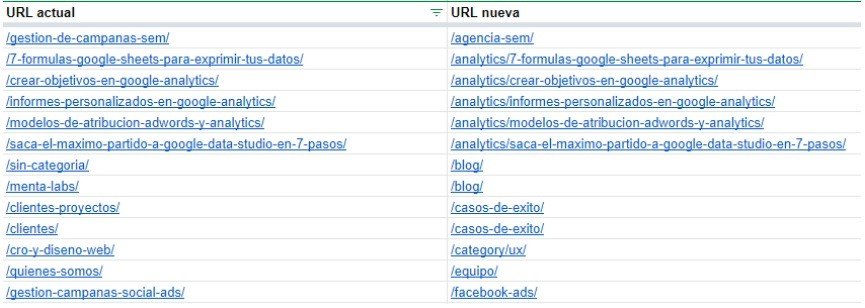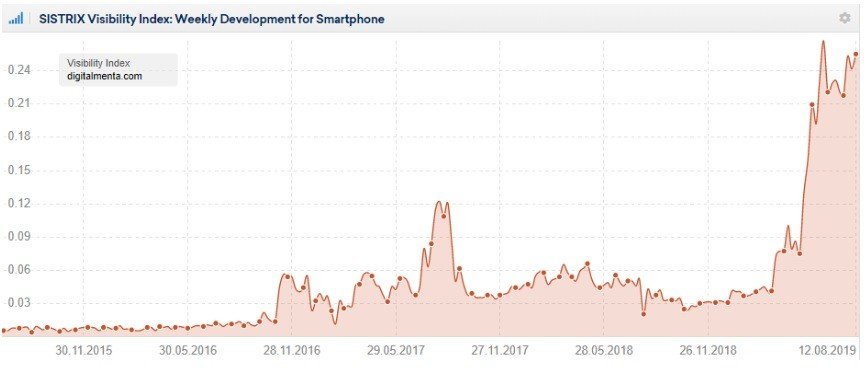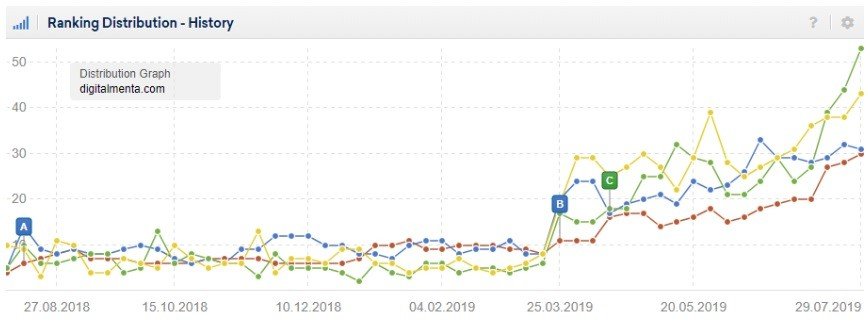Caso de éxito SEO
Hace unos meses nos pusimos a trabajar en un nuevo proyecto que ha sido todo un caso de éxito SEO, el rediseño de nuestra propia web. Había llegado el momento de que la antigua web de Digital Menta, una agencia de marketing online que hasta hace poco se centraba “únicamente” en servicios de PPC, se renovará e incluyera un espacio para los nuevos equipos de Diseño, Inbound y SEO.
Además de incluir las nuevas áreas de trabajo de la agencia, queríamos renovar la imagen de la web anterior, en la que los servicios eran latas de refresco y se había quedado algo anticuada.

Características del proyecto
Las características principales del proyecto son:
- El nuevo equipo de diseño de Digital Menta es el encargado de crear el nuevo diseño.
- El dominio no cambia
- La arquitectura del sitio cambia:
- Se crean nuevas páginas que describen los servicios que ofrece la agencia.
- Se crean nuevas categorías en el blog correspondientes a las áreas de trabajo en las que trabajamos.
- Cambia la taxonomía de las URLs
Fase I: La importancia de un diseño “SEO-friendly”
Lo primero que hacemos desde el equipo SEO es participar en el proceso de diseño de la web. Colaboramos con el equipo de diseño para asegurarnos de que la web va a estar correctamente optimizada para los buscadores. Además de tener un diseño responsive, hay dos puntos fundamentales para SEO:
- El entrelazado interno: Tenemos que asegurarnos de que el entrelazado va a ser el adecuado, vamos a poder definir los textos ancla y los enlaces van a ser rastreables por los buscadores.
- El contenido: vamos a poder definir el contenido (único y original) y el formato de cada una de las páginas de manera que los buscadores van a poder leerlo.
Fase II: Inventario de la web actual
Con el proceso de cambio a una nueva web en la que las URLs van a cambiar y van a ser nuevas para los buscadores es importante que se redirijan adecuadamente las URLs antiguas a las nuevas para no perder el posicionamiento orgánico y el tráfico actual.
Por eso recopilamos todas las URLs de la web actual utilizando varias herramientas:
- Rastreo de la web con screaming Frog
- URLs indexadas del Informe de cobertura de Google Search Console
- URLs con impresiones en Google Search Console
- URLs con tráfico en Google Analytics
- Sitemap antiguo
Fase III: Análisis de las páginas actuales
Cuando ya tenemos una lista con todas las páginas que hemos podido encontrar podemos analizar si merece la pena mantenerlas en la nueva web. Cuando ya contamos con páginas bien posicionadas tenemos que asegurarnos de que el contenido se va a mantener en la página correspondiente de la nueva web.
Por desgracia, no todas las páginas que encontramos están bien posicionadas. Entre las páginas antiguas encontramos:
- Artículos del blog que han quedado anticuados y que tendremos que actualizar o eliminar (tanto de la web como del índice de Google).
- Varios artículos del blog que hablan del mismo tema que tendremos que unificar.
- Artículos que no están clasificados en la categoría correcta, ya que hasta el momento no había consistencia en la clasificación de los artículos por categorías. En estos casos definimos la categoría correcta y eliminamos las que son repetitivas o se han creado de manera aleatoria. También eliminamos la mayoría de etiquetas de los artículos del blog.
- Artículos que se han eliminado pero siguen indexados en Google. Son páginas que dan error 404 y debemos gestionarlas adecuadamente para que desaparezcan de las páginas de resultados de búsqueda.
Decidimos qué va a pasar con cada una de las páginas encontradas y definimos la URL de cada una de ellas en caso de que se vayan a mantener en la nueva web. Tenemos que tener en cuenta que el contenido antiguo deberá mantenerse si no queremos perder el posicionamiento de cada una de las páginas.
Al final obtendremos un documento que nos ayudará a definir todas las redirecciones que se van a hacer.
Fase IV: Definición de la estructura y el contenido
Como participamos en el proceso de diseño, ya conocíamos qué apartados y qué tipos de página iban a conformar la nueva web pero teníamos que definir qué contenido iba a tener cada una de las páginas. En algunos casos mantenemos el contenido antiguo sin realizar ningún cambio, en otros actualizamos el contenido y en otros casos tenemos que crearlo, como en el caso de las páginas que hablan de nuestros nuevos servicios.
En este proceso nos guiamos por un estudio de palabras clave en el que incluimos:
- Términos de búsqueda de Google Search Console: son los términos para los que la web actual ya está posicionada y debemos tenerlos en cuenta para poder mantener o incluso mejorar los rankings y el tráfico orgánico actuales. Gracias al add-on Search Analytics for Sheets podemos exportar estos términos con la página que está teniendo impresiones y clics en cada una de esas búsquedas.
- Palabras clave de la competencia: utilizamos herramientas como Sistrix para obtener las palabras clave de sitios web especializados en marketing digital en España.
- Sugerencias de palabras clave obtenidas de keywordtool.io a partir de términos genéricos.
Cuando ya hemos recopilado todas las palabras clave que pueden ser interesantes para Digital Menta añadimos el volumen de búsqueda de cada una para poder priorizar por la cantidad de tráfico orgánico que podrían aportar esas búsquedas. A continuación les asignamos una URL, que puede ser una de las páginas de la web antigua o una nueva, correspondiente a uno de los nuevos servicios de la agencia. También puede ser propuesta como tema para un artículo del blog.
Además tenemos en cuenta que hay palabras clave que pueden agruparse por su similitud o porque consideramos que la intención de búsqueda del usuario es la misma, por ejemplo al buscar “agencia de marketing online” y “agencia de marketing digital” el usuario está buscando lo mismo aunque use términos diferentes y por tanto la página en la que aterrice puede ser la misma. Por ese motivo asignamos una o varias palabras clave relacionadas semánticamente a cada una las páginas de Digital Menta.
A la hora de elegir las palabras clave, y aunque posicionar la web para términos genéricos puede aportar mayor visibilidad y tráfico orgánico, también tenemos en cuenta palabras clave específicas para las que suele haber menor competencia a la hora de posicionarse en Google.
Fase V: Optimización y creación de contenido
Gracias al documento que hemos obtenido con el estudio de palabras clave ya sabemos si hay páginas bien posicionadas o que con alguna pequeña optimización podían pasar a estarlo. Además, si ya tenemos un artículo bien posicionado para una búsqueda determinada no es recomendable intentar posicionar otra página. En caso de que creáramos un nuevo artículo enfocado a posicionar esa misma palabra clave debería competir con la página que ya está posicionada, por lo que podría tener un impacto negativo en el posicionamiento actual.
Revisamos el contenido que ya existe en la web de Digital Menta y optimizamos varios elementos:
- Meta-título y meta-descripción: Comprobamos que incluyen la palabra clave objetivo, que no son demasiado largos y que son atractivos para los lectores con el objetivo aumentar el CTR.
- Enlaces rotos y redirecciones: Corregimos los enlaces que apuntan a páginas que dan error 404 y a páginas redirigidas para que apunten a la URL correcta.
- Texto ancla de enlaces internos: Revisamos los textos ancla y los optimizamos para que incluyan la palabra clave asignada a la página a la que están apuntando.
En cuanto a las páginas nuevas, nos encargamos nosotros mismos de redactar las páginas que describen nuestros servicios incluyendo las palabras clave asignadas, listas, imágenes optimizadas y, sobre todo información que creemos relevante para un usuario que entra en nuestra web.
Fase VI: Revisión de la nueva web
Cuando la web se encuentra en modo de prueba comprobamos de nuevo que la nueva plantilla incluye todo lo que habíamos propuesto al inicio del proyecto y que todos lo elementos que afectan al posicionamiento web están bien configurados:
- Etiquetas canonical
- Migas de pan
- Estructura de encabezados lógica
- Paginación
Además debemos asegurarnos de que la versión provisional de la web no se indexe en Google para evitar problemas de contenido duplicado.
Fase VII: Nacimiento de la nueva web
Finalmente y tras todo el esfuerzo ¡lanzamos la nueva web con el nuevo diseño!
Ya en producción nos encargamos de comprobar que todo funciona según lo previsto:
- Google Analytics: Incluimos el código de Google Analytics y comprobamos que funciona.
- Redirecciones: configuramos el archivo htaccess y comprobamos que todas las URLs que obtuvimos en la fase de “inventario” están redirigidas correctamente. Esto podemos hacerlo rastreando todas las URLs antiguas en modo lista en Screaming Frog
- Sitemap: Configuramos y creamos el nuevo sitemap y lo envíamos a través de Google Search Console.
- Archivo robots.txt: Configuramos el archivo para excluir las partes de la web que no queremos que rastreen los bots.
- Errores 404: Rastreamos la nueva web con Screaming Frog para detectar y solucionar errores 404
Resultados
Después de lanzar la web en abril de 2019 conseguimos que la visibilidad de la web crezca y además vaya en aumento, como se puede observar en la gráfica de visibilidad de Sistrix.
Al observar la distribución de rankings también vemos que va aumentando el número de palabras clave posicionadas en las páginas 1, 2 y 3 de Google.
Gracias a este aumento en visibilidad el número de usuarios ha aumentado un 47%
Resumen: SEO como proceso de mejora contínua
Aparte de actualizar el contenido si se ha quedado anticuado, mejoramos el entrelazado interno, añadiendo enlaces a artículos relacionados y a las páginas que describen nuestros servicios y modificando el texto ancla de los enlaces actuales para que se correspondan con las palabras clave que hemos definido en el análisis previo, lo que nos ayuda a posicionar mejor las páginas que consideramos más importantes. Por otro lado, nos encargamos de optimizar las imágenes de algunos artículos que no se optimizaron en el momento de su publicación. Comprobamos el nombre de archivo, las etiquetas alt y title y el tamaño de archivo.
En resumen, y aunque el proceso de rediseño ha sido un éxito, para poder seguir mejorando el posicionamiento debemos seguir trabajando en la optimización y actualización del contenido, algo que se convierte en una tarea recurrente y en la que contamos con la participación de todo el equipo de expertos en marketing online de Digital Menta.








